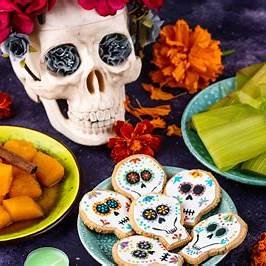
The Day of the Dead (Día de los Muertos) is a vibrant celebration in Mexican culture that honors deceased loved ones while celebrating life. Food plays a central role in these festivities, serving as both offerings to the departed and a means of bringing families together. This exploration will delve into the traditional dishes, symbolic offerings, and family gatherings that characterize this unique holiday.
Traditional Dishes of Día de los Muertos
1. Pan de Muerto (Bread of the Dead)
Pan de Muerto is perhaps the most iconic food associated with Día de los Muertos. This sweet bread, typically flavored with orange blossom water and decorated with bone-shaped pieces, symbolizes the cycle of life and death. It is an essential offering on altars (ofrendas) dedicated to the deceased and is often enjoyed by families during the celebrations. The bread’s soft texture and sweet flavor make it a beloved treat throughout Mexico, available in bakeries and homes in the weeks leading up to the holiday12.
2. Calaveras (Sugar Skulls)
Calaveras, or sugar skulls, are colorful decorations made from sugar paste molded into skull shapes. These vibrant skulls are inscribed with the names of deceased individuals and placed on altars as offerings. The colors used in decorating calaveras carry symbolic meanings; for instance, red represents blood, purple signifies pain, and yellow symbolizes marigolds or nature. The presence of calaveras on altars highlights the joyous nature of the holiday while honoring those who have passed23.
3. Tamales
Tamales are a traditional Mexican dish made from masa (corn dough) filled with various ingredients such as meats, cheeses, or vegetables, wrapped in corn husks and steamed. During Día de los Muertos, tamales are prepared in large quantities and shared among family members. They represent community and togetherness while honoring ancestral culinary practices. In different regions of Mexico, tamale variations exist; for example, uchepos (corn tamales) are popular in Michoacán, while Chiapas features tamales filled with grasshoppers12.
4. Sopa Azteca (Tortilla Soup)
Sopa Azteca is a spicy tortilla soup that is commonly enjoyed during Día de los Muertos celebrations. Typically served with toppings such as avocado, cheese, and chicharrón (pork rinds), this comforting dish embodies warmth and hospitality. Families often gather to prepare and share this dish during the festivities, reinforcing familial bonds12.
5. Mole
Mole is a rich sauce made from various ingredients including chiles, spices, nuts, and chocolate. It is often served over meats such as turkey or chicken during Día de los Muertos celebrations. Each family may have its own unique mole recipe that has been passed down through generations, making it a significant part of their culinary heritage23.
6. Calabaza en Tacha (Candied Pumpkin)
Calabaza en tacha is a sweet treat made from pumpkin chunks cooked in syrup with spices like cinnamon and sugar. This dessert has pre-Hispanic roots and is particularly associated with the Yucatán Peninsula but enjoyed throughout Mexico during Día de los Muertos. It symbolizes abundance and sweetness in life12.
7. Atole
Atole is a traditional warm drink made from masa harina (corn flour) mixed with water or milk and flavored with cinnamon or chocolate. It is often consumed alongside pan de muerto during celebrations, providing nourishment and comfort during the festivities23.
Symbolic Offerings on Altars
During Día de los Muertos, families create altars known as ofrendas to honor their deceased loved ones. These altars are adorned with photographs, flowers (particularly marigolds), candles, incense, and food offerings that reflect the preferences of the departed.
- Cempasúchil Flowers: The bright orange marigold flowers symbolize death and are believed to guide spirits back to their altars.
- Photographs: Personal mementos such as photographs of deceased family members serve as reminders of their lives.
- Candles: Lighting candles represents hope and faith while illuminating the path for spirits returning to visit their families.
Food offerings on these altars not only nourish the spirits but also serve as a way for families to connect with their ancestors during this sacred time123.
Family Gatherings: Celebrating Life Together
Food plays an essential role in fostering connections among family members during Día de los Muertos celebrations. The preparation of traditional dishes often involves communal efforts where families come together to cook, share stories about their loved ones, and reminisce about cherished memories.
The act of sharing meals during these celebrations creates opportunities for dialogue and relationship-building within families. Unlike typical funerals that may evoke sadness, Día de los Muertos emphasizes joy through food and celebration—an acknowledgment that death is part of life’s cycle.
Families also invite friends and neighbors to partake in meals prepared for the festivities, creating an inclusive atmosphere that celebrates life while remembering those who have died123.
Conclusion: The Vibrant Role of Food in Día de los Muertos
In summary, food plays a powerful role in defining the cultural significance of Día de los Muertos in Mexico. Through traditional dishes like pan de muerto, tamales, mole, and more, families honor their deceased loved ones while celebrating life itself. The act of preparing and sharing food fosters connections among family members and communities alike.
As Día de los Muertos continues to evolve—both within Mexico and among Mexican communities worldwide—the culinary traditions associated with this holiday remain vital expressions of cultural identity. They remind us that food is not just sustenance; it embodies love, memory, and continuity across generations. By embracing these culinary customs during Día de los Muertos, individuals participate in a rich tapestry of cultural heritage that celebrates both life and death in vibrant harmony.
